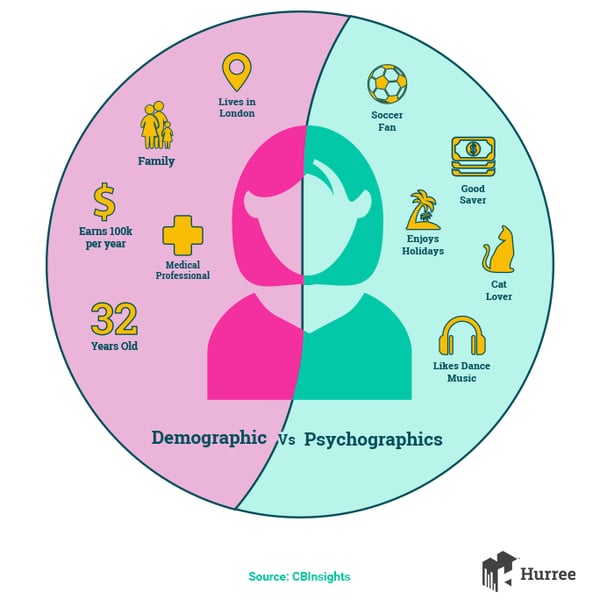What is Psychographic Segmentation: The Basics for Marketers
Every company wants to make sure their customers feel like they matter, right? And for this to be possible, customers must be treated as individuals, with unique wants and needs.
Personalization is an important part of the customer experience journey. The evidence increasingly shows that customers want to be treated like individuals and not just a monolith.
.png?width=573&height=146&name=psychographic%20Blog%20(1).png)
Source: Epsilon
To properly personalize your content for your prospects and customers, you first have to understand them. That’s why market segmentation is so important for any business. While demographic segmentation is probably the most well-known - think age, income, gender, etc. - other types of segmentation can be equally as important in creating a personalized experience that will delight. One such type is psychographic segmentation, and it’s the one we’ll be going over in detail.
First, let’s start with the basics.
What is psychographic segmentation?
Psychographic segmentation is a strategic marketing approach that divides a target market based on psychological characteristics, such as beliefs, values, interests, and lifestyles. By understanding the deeper motivations and preferences of customers, businesses can tailor their products, messaging, and marketing strategies to better resonate with specific segments, leading to more effective and targeted campaigns.
It comes from the study of psychographics - psychological attributes like personality, values, attitudes, opinions, interests, and lifestyles. This method goes beyond traditional demographic segmentation, allowing businesses to create more personalized and engaging experiences for their audience.
Collecting psychographic data from prospects and customers involves gathering information about their attitudes, interests, values, lifestyle choices, personality traits, and behaviors. Here's how you can do it:
- Surveys and questionnaires: Create surveys or questionnaires that delve into various aspects of your audience's lives, preferences, and opinions. Ask questions about their hobbies, interests, values, purchasing motivations, media consumption habits, and lifestyle choices. Online survey tools or email campaigns can be used to distribute these surveys to your target audience.
- Customer interviews and focus groups: Conduct one-on-one interviews or organize focus group discussions with your customers to gain deeper insights into their psychographic profiles. Engage in open-ended conversations to explore their attitudes, beliefs, and experiences related to your products or services. This qualitative approach can uncover valuable nuances and motivations that quantitative methods may miss.
- Social media monitoring: Monitor social media platforms to observe how your audience interacts, engages, and communicates online. Analyze their posts, comments, likes, and shares to glean insights into their interests, preferences, and lifestyle choices. Social listening tools can help track relevant conversations and trends across various platforms.
- Website analytics: Analyze visitor behavior and engagement metrics on your website to understand how your audience navigates and interacts with your online content. Look for patterns in page views, session durations, and content interactions to infer their interests, preferences, and motivations. Tools like Google Analytics provide valuable data on user demographics and interests.
- Purchase history and transactional data: Analyze customer purchase history and transactional data to identify patterns and preferences related to product categories, brands, price points, and purchase frequency. This information can reveal insights into their lifestyle choices, interests, and values based on their buying behavior.
- Third-party data sources: Explore external data sources such as market research reports, industry publications, and consumer behavior studies to supplement your internal data collection efforts. These sources may provide valuable insights into broader trends, preferences, and psychographic profiles within your target market.
- Behavioral tracking: Implement tracking mechanisms, such as cookies or user accounts, to monitor user behavior across digital channels. Track interactions, engagement levels, and content consumption patterns to infer psychographic characteristics and preferences. However, ensure compliance with data privacy regulations and obtain user consent where necessary.
The history of psychographic segmentation
Psychographic segmentation has its roots in the early to mid-20th century when marketers began to recognize that understanding consumer behaviour required deeper exploration and understanding of psychological and lifestyle factors. This approach emerged as a response to the limitations of traditional demographic segmentation, which focused solely on quantifiable characteristics like age, gender, and income.
In the 1950s and 1960s, pioneering market researchers such as Ernest Dichter and William Wells laid the groundwork for psychographic segmentation by exploring the psychological motivations and lifestyle preferences that influence consumer choices. Dichter, often considered the "father of motivational research," conducted in-depth interviews and psychoanalytic studies to uncover the underlying desires and fears that drive consumer behaviour. Wells, on the other hand, developed the AIO (Activities, Interests, and Opinions) framework, which classified consumers based on their interests, hobbies, and values. These early efforts paved the way for the development of more sophisticated psychographic segmentation techniques in the decades that followed.

Psychographic vs. demographic segmentation
This doesn’t mean that demographic segmentation isn’t useful, it merely means we have to carefully look at the differences between the two and see where they can be applied.
As we mentioned, demographic segmentation categorizes consumers based on quantifiable characteristics like age, gender, income, and education level. It provides valuable insights into who your customers are demographically, making it useful for targeting specific demographic groups with tailored marketing messages and products. However, it doesn't capture the nuances of individual preferences and lifestyles.

On the other hand, psychographic segmentation delves into the psychological and lifestyle characteristics of consumers, such as their values, beliefs, interests, and personality traits. It goes beyond demographics to understand why consumers make certain choices and how they perceive products or brands. Essentially, it provides valuable insights into consumer motivations. This deeper understanding allows marketers to create more personalized and resonant marketing campaigns that appeal to consumers on an emotional level. Brands focusing on psychographic data do so for a number of reasons: to increase engagement, entice new target markets, improve customer experiences or they could simply be curious about their consumers.
In essence, while demographic segmentation tells you who your customers are, psychographic segmentation tells you why they buy. It helps marketers create more targeted and effective strategies by uncovering the motivations and preferences that drive consumer behavior.
Psychographic case studies: Facebook and Apple
How Facebook redefines targeted advertising
In 2023, Facebook boasted a staggering 3.049 billion monthly active users, solidifying its position as the world's largest app. Unsurprisingly, Facebook's dominance extends to advertising and promotion, thanks to its adept use of psychographic segmentation. With a vast reservoir of user data at their disposal, Facebook tailors content based on users' interests, opinions, values, hobbies, and lifestyle choices.
Over years of data collection, Facebook's advertising tool has honed the ability to target content and messages using a wealth of consumer information. While Facebook exemplifies the potential of social media for positive psychographic segmentation, it also underscores its darker side. The infamous Cambridge Analytica data scandal serves as a stark reminder of how personal data can be misused without consent. As consumers become more wary of sharing personal information online, it highlights the importance of understanding the implications of psychographic segmentation and the need for data privacy.
Facebook is renowned for its extensive use of user data to drive targeted advertising and enhance user experience. With over billions of monthly active users worldwide, Facebook's ability to harness data insights is unparalleled in the digital landscape. One of the key methodologies it employs is psychographic segmentation, allowing advertisers to target audiences based on their interests, attitudes, and behaviors.
How Facebook uses psychographic segmentation:
- User profiling: Facebook collects vast amounts of data on user interests, preferences, and behaviors, creating detailed user profiles.
- Tailored advertising: Advertisers can leverage psychographic data to create highly targeted ad campaigns that resonate with specific audience segments.
- Personalized content: By understanding users' psychographic profiles, Facebook delivers personalized content, including posts, ads, and recommendations.
- Audience insights: Facebook provides advertisers with valuable insights into audience demographics and psychographics, enabling them to refine targeting strategies.
- Behavioral targeting: The platform utilizes psychographic insights to target users based on their online behaviors and interactions.
- Custom audiences: Advertisers can create custom audience segments based on psychographic traits, ensuring their ads reach the most relevant users.
- Dynamic ads: Facebook's dynamic ad formats use psychographic data to automatically tailor ad content based on user preferences and behaviors.
- Lookalike audiences: Marketers can create lookalike audience segments based on psychographic similarities to existing customers, expanding their reach to new prospects with similar traits.
- Ad relevance scores: Facebook evaluates ad relevance based on psychographic alignment, ensuring that ads are served to users most likely to engage with them.
- Engagement optimization: Psychographic segmentation helps optimize ad delivery and engagement, maximizing the effectiveness of advertising campaigns.
In summary, Facebook's utilization of psychographic segmentation empowers advertisers to deliver highly targeted, personalized marketing messages, resulting in increased ad relevance, engagement, and overall campaign success.
Delving into Apple's segmentation strategy
Apple is a beacon of innovation and creativity in the technology industry. Renowned for its sleek design, cutting-edge technology, and user-centric approach, Apple's brand personality is as dynamic as its global presence.
These attributes are reflected in Apple’s desired target market; a focus on consumers with specific lifestyles and personalities. For example, as Apple products offer great user experiences, continuous product updates, and the ease of listening to music on the go, we can assume that their target audience may also be passionate about music, technology or new trends.
By embracing psychographic segmentation, Apple has honed its marketing strategies to resonate deeply with specific consumer lifestyles and personalities, solidifying its position as a market leader.
How Apple utilizes psychographic segmentation:
- Brand identity: Apple positions itself as a brand synonymous with innovation, creativity, and excellence, attracting consumers who align with these values.
- Target audience focus: Apple's products cater to consumers who value user experience, product updates, and seamless integration, such as tech enthusiasts, trendsetters, and music aficionados.
- Data collection: Apple leverages data from iTunes downloads and product purchases to gain insights into user personalities, behaviors, and lifestyles.
- Targeted marketing: Armed with a wealth of consumer data, Apple crafts targeted marketing campaigns tailored to specific psychographic segments, ensuring relevance and resonance.
- Personalized content: By understanding user preferences and behaviors, Apple delivers personalized content, recommendations, and product offerings to its diverse consumer base.
- Innovative promotion: Apple's marketing initiatives reflect its brand personality, employing innovative and trend-setting promotional strategies that captivate audiences and reinforce its image as vibrant and on-trend.
- Data-driven strategies: Apple's marketing strategies are intricately woven around psychographic segmentation insights, allowing the company to design campaigns that effectively reach and engage with its target audience.
- Commitment to personalization: Apple prioritizes personalization in its marketing efforts, striving to deliver tailored experiences that resonate with individual psychographic profiles.
In summary, Apple's innovative use of psychographic segmentation enables it to connect with consumers on a deeper level, delivering personalized experiences that resonate with diverse lifestyles and personalities while upholding privacy and accountability standards.
Conclusion
Psychographic segmentation is a powerful tool for brands and marketers, offering a myriad of benefits. However, it also comes with its own set of challenges. Unlike demographic data, obtaining psychographic insights can be more complex and nuanced. It’s also crucial to establish clear guidelines to ensure the accurate and secure use of this data that is compliant with privacy regulations like GDPR.
But, in the end, by harnessing the wealth of available data and gaining a deep understanding of their consumers, brands can tailor unique user experiences and create compelling content. The integration of psychographic segmentation into marketing strategies can lead to tangible benefits such as increased ROI, heightened brand affinity, and enhanced customer loyalty. Just remember, it's paramount to use this data ethically, responsibly, and in the right contexts to foster trust and transparency with consumers.
Segmentation works best when you can track and analyze your data. Try Hurree today and discover how to truly harness the power of analytics and transform your data ecosystem. If you have any questions then feel free to get in touch!

Share this
You May Also Like
These Related Stories

The Pros and Cons of Demographic Segmentation

Behavioural Segmentation: 3 Case Studies


